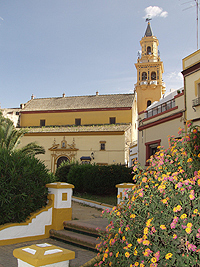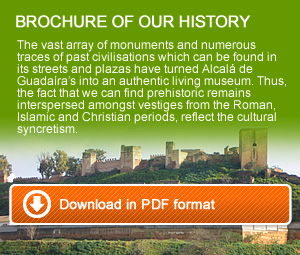

Primitive parish churches of Alcalá belong to the Mudéjar Period, dating back, in most of the cases, form the 14th century. There is a certain degree of discussion in connection with the date of Santa María's construction, placed in the higher neighbourhood of the Castle Hill. It has been traditionally stated the possible pre-existence of a mosque in the location of Santa María, although archaeological researches made at the surroundings of the church have ruled out the existence of an Andalusí city (madina), and no archaeological researches in the church have been made in order to allow knowing its origin.
Among the most remarkable elements of Santa María we find the bell tower, made with ashlars and brick. Its top was restored in the 1940s decade, but along with the main façade it allows us to classify the building in the group of Mudejar Sevillian churches of the 14th-15th centuries. A possible sign of an earlier date (second half of the 13th century) could be the wall fresco dedicated to Saint Matthew, located in the head of the southern nave of the church.

Along the Late Middle Ages (14th-15th centuries) they rest of primitive parish churches of Alcalá are dated: San Miguel (St. Michael), Santiago el Mayor (St. James the Greater or St. Jacob) and San Sebastián (St. Sebastian). San Miguel arose like the parish church of the poor quarter of the same name, within the urban expansion of Alcalá during the 14th century. The building inside has been totally reconstructed, because there is documented record that at the beginning of the 20th century only the façade remained standing, as a consequence of the abandon of the poor quarter from the Modern Age.
In the cases of Santiago and San Sebastián, the Mudéjar buildings were widely transformed in the 18th century, modifying roofs and the general distribution of the buildings. San Sebastián's case is an example of hermitage turned into parish church during the Modern Age, as a consequence of the urban development of the northeast sector of Alcalá de Guadaíra. On the contrary, from the Alcalá's hermitages we know through documentary sources (San Roque -St. Rocco-, Santa Lucía -Saint Lucy- and Santa Catalina -Saint Catherine-), only San Roque's hermitage is left, placed on the hill of the same name, next to the beginning of the Road to Utrera.
Last kind of ecclesiastic buildings are the convents, among those that have reached our time there is Santa Clara (Saint Clair), at the Santa María del Águila Street. It did not happen that way with the San Francisco's (Saint Francis), missing in the last century under a contemporary building. And the case of the Convent of San Juan de Dios (St. John of God) is quite singular, as it is the Town House of Alcalá; the pictures from the cloister could be recovered a few years ago.


